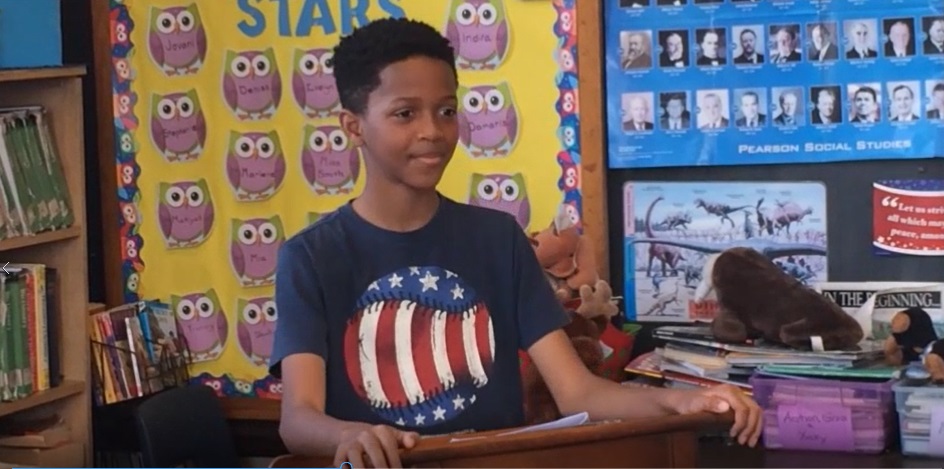
Video Pieces and Short Analytics on a Classroom Mock Trial on the Jamestown Colony
At the end of SY2017, one of our partner middle schools — James Otis School, a rising neighborhood K-8 school on Chicago’s near northwest side — implemented the mock trial project we developed for a unit on the early Jamestown colony in North America in the early 17th century, based on the excellent and multiple-award winning young adult novel, Blood on the River. The debatable issue at the heart of this argument-centered project is
Was the British aristocracy (i.e., those who ruled because of the family they were born into), according to Blood on the River, responsible for poisoning the colonies’ relationship with the native population in America?
And the full project was laid out in an earlier Debatifier post, here. This post will consist of several video clips from this implementation, led by veteran educator Janet Smith, along with brief analytics attached to each clip, highlighting two proficiencies and one deficiency.
Opening Arguments for the Prosecution

Analytics
The arguments for the prosecution are well organized and structured in a properly subordinate way to this team’s overall position. The three arguments made by this young barrister — quite clearly in his speech and in his written and prepared statements, which were also turned in — arguing for the “state” in prosecuting the English aristocrats are:
The English aristocrats were lazy and wanted others to do their work for them.
The English aristocrats lied to keep their power.
And the native population showed the gentlemen generosity that the the English didn’t return.
The evidence supporting each of the above claims is well chosen and directly aligned. The evidence supporting the second claim, for example, is an accurate summary of the incident recounted in the novel where Captain Newcombe basically frames the commoner John Smith, in order to try to place a severe check on Smith’s growing influence with the colonists.
As Ms. Smith notes in the video, though, the barrister needs to practice increasing the volume of his speech. Some classrooms use a five-point scale of speaking volume. Classroom debating and structured argumentation should be pitched at about a four, when performed in front of a full class, and a three when performed at tables around a classroom simultaneously.
Cross-Examination — The First Example
Analytics
The barrister for the defense in this cross-examination is demonstrating the advanced academic skill of building her questions around the text. Text-dependent questions, formulated by students themselves, are an important part of this project. Each question she asks is born out of a passage that she has flagged and annotated in the text as especially significant for the interpretive case her team is making that the English aristocrats are not guilty of poisoning relations with the native population.
This barrister is also successfully demonstrating the linkage between her questions of the character from the novel who is a testifying witness and the interpretive arguments her team is advancing in the trial. Here, she is asking this witness why it is that the English aristocrats should have been expected to trust the native population when, according to one passage in the text (which the barrister quotes), the native population initiated an attack on the Jamestown colony that was unprovoked. She is using her cross-examination to try to elicit testimony that supports one of her side’s main arguments, in a cogent and well-planned manner.
The student in the witness chair, who is role-playing a character from the novel (Master Wingfield, an English aristocrat who was one of the original Jamestown colonists), does draw from her prepared notes and graphic organizers, but she doesn’t quite present testimony that is supportive of this character’s overall position on the debatable issue, which is obviously that the aristocrats are not guilty as charged.
Cross-Examination — The Second Example

Analytics
This barrister for the defense does a very fine job throughout her cross-examination (and she did so throughout the trial). But to pick up on one exemplary academic move, in her second question she does some clever but logically-grounded interpretive work to turn around an argument being made by the prosecution — namely, that the natives were much friendlier to the English gentlemen than the gentlemen were to the natives. The barrister here presses the witness that this could just as easily mean that the natives were impressed by and felt an admiration for the English aristocrats. Here this student is attempting to turn a weakness of their position into a possible strength, an advanced form of thinking critically and skeptically about contrary or competing argumentation.
The character witness here — playing the young narrator of the novel, commoner Samuel Collier — parries aside this line of questioning by arguing that the barrister’s interpretation could be true, for awhile, but the continued mistreatment of the natives led them soon enough to mistrust and even detest the English gentlemen. This is an example of critical thinking in action, with the student playing Collier finding a flaw or weakness in the temporality of the other side’s line of argument.
The student playing Samuel Collier is effective in her role, but more through her extemporaneous thinking and processing than for close textual preparation. She can be quite formidable with more work with the graphic organizers, next time.
Closing Arguments for the Prosecution

Analytics
This student-barrister demonstrates that he took careful notes through the testimony of the character witnesses, and that he is able to quickly and mostly correctly apply that testimony to the prosecution’s three arguments, adding additional testimonial evidence for their argumentation and their overall position in the trial.
This barrister even assays to take on and refute the defense’s arguments in his closing arguments. You can hear this when he refers to “the other side’s first argument was . . . .” His use of specific testimony at these points in his speech could have been more lucid, crisper, and more direct, but there is a victory in this student’s clear understanding of the burden of refutation that powerful and convincing argumentation (especially closing or concluding argumentation) has, and there are moments in the speech in which his refutation lands.
The other notable flaw in this student’s performance (in addition to some missing directness or connectedness in his refutation) is simply the monotone he adopts in style: the absence of speaking dynamics. The adjustment of tone and volume in one’s speaking, in performed and presented argumentation like this, is akin to certain stylistic devices in writing (e.g., alliteration, imagery, chiasmus, metaphor — though all of these devices are also options in oral argument), and its absence parallels a drab tone on the page.
A Final Note
The implementation of this project was a resounding success at Otis Middle School in June, 2017, according to all who observed it and most especially according to veteran teacher Janet Smith. As she later noted: “The project — in fact, argument-centered education all year long — brought out capacities for thinking, careful reflection, and insight that I hadn’t seen from the students otherwise. It engaged them — and in real academic work. An ideal preparation for next year, and beyond next year.” The flaws in student performance are actually valuable too as specific challenges for all of us, going forward.

